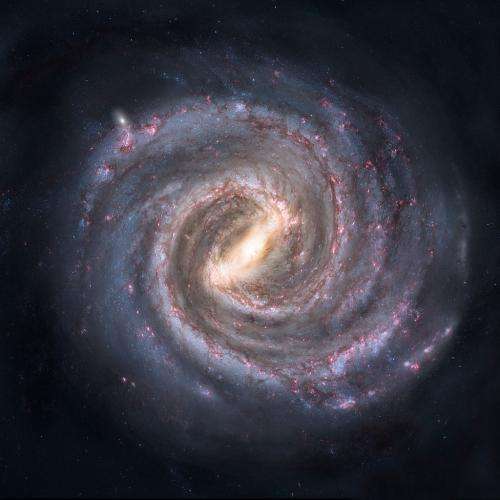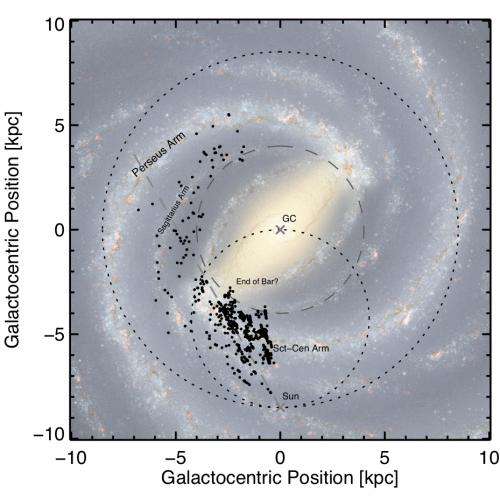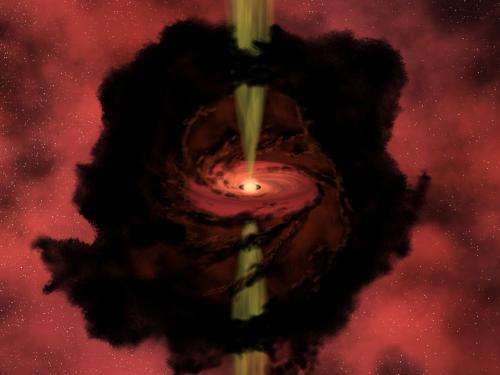Research maps where stars are born

(Phys.org) —A University of Arizona-led group of astronomers has completed the largest-ever survey of dense gas clouds in the Milky Way – pockets shrouded in gas and dust where new stars are being born.
A team of astronomers led by Yancy Shirley at the University of Arizona's Steward Observatory has completed the largest-ever survey of dense gas clouds in the Milky Way – pockets shrouded in gas and dust where new stars are being born. Cataloging and mapping more than 6,000 gas clouds, the survey allows astronomers to better understand the earliest phases of star formation.
"When you look at the Milky Way on a clear summer night, you'll notice it's not a continuous stream of stars," said Shirley. "Instead, you'll notice all those little dark patches where there seem to be no stars. But those regions are not devoid of stars – they're dark clouds containing dust and gas, the raw material from which stars and planets are forming in our Milky Way today."
According to Shirley, the survey is a major step forward in astronomy because it allows astronomers to study the earliest phases of star formation when the gas and dust in the star-forming clouds are just beginning to coalesce, before giving rise to clusters of stars. He explained that much of the research over the last 30 to 40 years has been very targeted towards regions where prospective stars, called proto-stars, have already begun to take shape.
"All the famous, major regions of star formation in our galaxy have been studied in great detail," Shirley said. "But we know very little about what happens in those star-less clumps before proto-stars form, and where."
The survey provides the first unbiased map of the galaxy that shows where all those regions are throughout the galaxy, in different galactic environments and at different evolutionary stages. This helps astronomers better understand how the properties of these regions change as star formation progresses.

"Starless clumps have only been detected in small numbers to date," Shirley said. "Now, for the first time, we have seen this earliest phase of star formation, before a cluster actually forms, in large numbers in an unbiased way."
According to the UA astronomer, the star formation rate in the Milky Way was higher in the past, and currently stars form on the order of about one solar mass per year.
How long does it take to become a full-blown star?
"That is something we hope to be able to calculate by comparing the number of sources that are in that early phase to the number of sources that are in a later phase," Shirley explained. "The ratio between the two tells you how long each phase lasts. In our survey there seem to be fewer regions that have not yet begun forming stars than those that have, which tells us the earlier phase must be shorter. If that phase lasted much longer, there should be many more of those."
Discover the latest in science, tech, and space with over 100,000 subscribers who rely on Phys.org for daily insights. Sign up for our free newsletter and get updates on breakthroughs, innovations, and research that matter—daily or weekly.
Because the dense accumulations of dust are impervious to light in the visible spectrum, astronomers can't observe them with telescopes detecting light in the visible spectrum such as the Hubble Space Telescope.
"For those of us who want to study how stars form, that's a real problem because if we want to observe a young star or a cluster of stars forming in one of those dark clouds, all that dust gets in the way," said Shirley.

However, it turns out the same dust that blocks visible light actually glows at long wavelengths, specifically radio wavelengths, which are about a million times longer than visible light.
"Heat emanating from the young clusters of stars forming inside the clouds, combined with ambient radiation and even starlight from the surrounding galaxy, all that heats up those dust grains just a little bit above absolute zero," Shirley said. "As a result they glow, allowing us to peer inside the clouds with a radio telescope at very long wavelengths."
For their survey, which covers all parts of the galactic plane visible from the northern hemisphere, the group used the Sub-Millimeter Telescope at the Arizona Radio Observatory, equipped with a sensitive new receiver. Shirley said the proximity and accessibility of the UA-operated telescope made this project possible in the first place.
The survey is published in The Astrophysical Journal.
More information: adsabs.harvard.edu/abs/2013arXiv1308.4149S
Journal information: Astrophysical Journal
Provided by University of Arizona




















